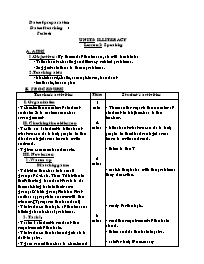Bài soạn môn học Tiếng Anh lớp 11 - Unit 5: Illiteracy - Lesson 2: Speaking

A. AIMS
1. Objectives : By the end of the lesson, sts will be able to:
- Talk about schooling and literacy related problems.
- Suggest solutions to these problems.
2. Teaching aids:
- blackboard, chalk, some pictures, handouts
- textbook, lesson plan
B. PROCEDURES
Bạn đang xem tài liệu "Bài soạn môn học Tiếng Anh lớp 11 - Unit 5: Illiteracy - Lesson 2: Speaking", để tải tài liệu gốc về máy bạn click vào nút DOWNLOAD ở trên
Date of preparation: Date of teaching : Period: Unit 5: illiteracy Lesson 2: Speaking A. Aims 1. Objectives : By the end of the lesson, sts will be able to: - Talk about schooling and literacy related problems. - Suggest solutions to these problems. 2. Teaching aids: - blackboard, chalk, some pictures, handouts - textbook, lesson plan B. Procedures Teacher’s activities Time Student’s activities I. Organization - T checks the number of students and asks Ss to make some class arrangement. II. Checking the old lesson - T calls on 1 student to talk about what we can do to help people in the disadvantaged areas learn to write and read. - T gives comments and mark. III. New lesson 1. Warm- up Matching game - T divides the class into small groups of 3-4 sts. Then T distributes the following handouts for sts to do the matching task in their own groups. Which group finishes first and has appropriate answer will the winner. (T prepares the handouts) - T introduces the topic of the lesson: talking about school problems. 2. Task 1: - T asks 1 student to read out the requirement of the task. - T introduces the task and gets sts to do it in pairs. - T goes round the class to check and offer help. - T calls on a student to read out the answers. - T checks the answers with the whole class and gives corrective feedback.T explains the new words and checking sts’ understanding by getting them to translate the sentences into VietNamese. Answers: 1. b-g 2. a-e 3. d-f 4. c-h 5. i-j 3. Task 2 - T asks 1 student to read out the requirement of the task. - T introduces the task and calls on two pairs of sts to read aloud the sample dialogue. - T elicits the structures that are used for asking for and giving suggestions - T writes some on the board. Asking for opinion: + What do yoy think we need to/could/ might/ ..... do? + What do you think about....? + What is your opinion about.....? Giving suggestions: + Maybe we can....... + We might want to...... + Probably we should ...... - T puts sts into groups of 3-4 and gets them to define the problems of their own school and suggest as many solutions as possible. They can use the ones in task 1 and add as many as they want to. -T goes around, controls, and helps. - T calls on some groups to present the problems and solutions they have identified. - T elicits feedback from the class and gives final comment. 4. Task 3: - T introduces the task: Sts are going to work together to identify the problems of their own classroom and offer solutions. - T gets sts to look at the given cues and elicits some more problems. Eg: + Class size: large class.... + Desks: not enough desks.... + Poorly equipped: no fans, lights,........ - T puts sts into groups of 3-4 and gets them to add more problems if they can, and work out the solutions. -T goes around, controls, and helps - T calls on the representative of each group to report their ideas to the class and elicits comments from the class. - T gives corrective feedback final comments. IV. Consolidation - T summarises the main points of the lesson. V. Homework - T asks sts to learn by heart all of the words and expressions used to ask for opinions and give suggestions. VI. Feedback 1. Good points 2. Weak points 1 min 4 mins 5 mins 8 mins 12 mins 12 mins 2 mins 1 min - The monitor reports the number of students in his/her class to the teacher. - talk about what we can do to help people in the disadvantaged areas learn to write and read. - listen to the T - match the photos with the problems they describe. - ready for the topic. - read the requirement of the task aloud. - listen and do the task in pairs. - ask for help if necessary - read out the answers. - check together and copy down. - read the requirement of the task aloud. - listen to T’s instructions and read aloud the sample dialogue. - tell the structures that are used for asking for and giving suggestions. - copy down - define the problems of their own school and suggest as many solutions as possible. - ask for help if necessary - present the problems and solutions they have identified. - listen - listen carefully. - give more problems. - copy down - add more problems if they can, and work out the solutions. - ask for help if necessary. - present and give comments. - listen. - take note - take note
Tài liệu đính kèm:
 Speaking 5.doc
Speaking 5.doc





